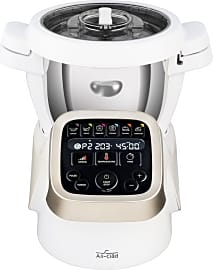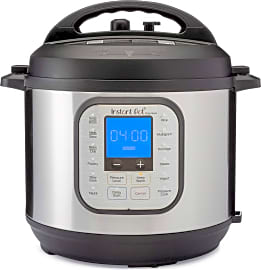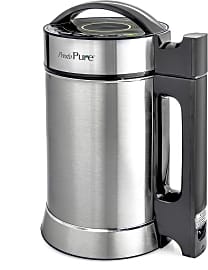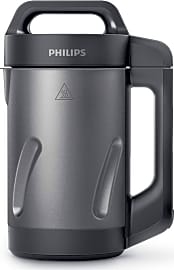The 8 Best Soup Makers

This wiki has been updated 39 times since it was first published in August of 2015. With one of these efficient and effective soup makers you can ensure your family eats only the freshest and healthiest ingredients without all the hassle of manual preparation. Some are also great for making all kinds of things, like cocktails, smoothies, baby food, and non-dairy milk, so you're sure to find plenty of uses for whichever selection you choose for our list. When users buy our independently chosen editorial picks, we may earn commissions to help fund the Wiki.
Editor's Notes
July 30, 2021:
We nixed the Vorwerk Thermomix because it's nowhere close to cost-effective for all but the richest users and we removed a KitchenAid model with poor availability and long-term reliability. The only other major change was the upgrade to the Vitamix 5200. We like this analog version quite a bit because there are no fancy electronic controls to malfunction and the large knob and switches are easy to use, even when your hands are dirty. Alternatively, if you really, really like to eat soup and want to make it as easily as possible, the Cedarlane Bellini Kitchen Master remains our top choice because of its in-depth control, high capacity and ease of use.
April 30, 2020:
A few models from our previous ranking have either been discontinued by their companies, or were supplanted by superior devices that were similar, but superior in form and/or function. The Breville Boss is a good example of the latter, as it intended to offer all the functionality of a blender, but with the addition of a heating element for cooking. The only problem there is that it's a large power draw the heat transfer of which is inefficient, as its insulation could only do so much to keep the element's heat from escaping through the housing. It also wasn't the best blender for ice and frozen fruit. Both the Vitamix 780 and the Blendtec Classic 575 Blender outperform it at just about every turn, with both of these high-end machines offering friction-based heating that requires no heating element.
If you don't already own a food processor, however, you might want to consider something like the All-Clad Prep & Cook, which boasts significant processing capabilities thanks to the inclusion of a number of blades and other tools. Once prepped, you can easily transition cooking portion of the process and have your soups and other dishes cooking in no time, without even changing the processing container.
Special Honors
Smart Living This model is designed to take most of the guesswork out of the process, provided you keep your ingredients within a reasonable size for it to stir them through the cooking chamber. Once you've piled everything into its stainless steel carafe, you simple choose smooth or chunky and let it do its thing. There aren't a lot of bells and whistles here, but there is reliability. thesmartlivingmop.com
The Cure For What Ails You
It also helps that soup contains a lot of liquid, as hydration is important when you're fighting a cold.
Hot soup always seems to make you feel better when you're sick. It's warm, simple, and soothing, and whether it's a homemade or canned variety, it just tastes good. But it may be more than just a feel-good remedy. Research shows that chicken soup, in particular, can help to treat certain symptoms of cold, flu, and other viruses.
In 2000, Dr. Stephen Rennard of the University of Nebraska Medical Center in Omaha conducted a study to try to pinpoint the reason behind this supposed wives' tale, using his own wife's recipe for chicken soup that was passed on by her Lithuanian grandmother. He took blood samples from volunteers and discovered that the soup suppressed the movement of a type of white blood cell that defends the body from sickness, which in turn reduced upper respiratory symptoms like coughing and congestion.
What's even more interesting is that scientists have not yet been able to figure out exactly which ingredients in homemade soup help to alleviate cold symptoms, but they think it could be due to how the nutrients in the chicken and vegetables work together. They also tested some store-bought soups and found them to have similar infection-fighting effects, which is great news for people who aren't so savvy in the kitchen.
Common sense theories conclude that proper homemade chicken soup is rich in minerals such as zinc, calcium, and magnesium after the bones are cooked for a few hours. Vegetables like carrots, celery, onions, and leeks add additional minerals like selenium and phosphorous. It also helps that soup contains a lot of liquid, as hydration is important when you're fighting a cold. But even if it's simply the placebo effect at work, as long as it makes you feel better, who cares?
A Brief History Of Soup Making
Soup is so ubiquitous in virtually every cuisine across the planet that it's easy to assume it's been around since the dawn of time. But everything has to start somewhere, and soup is no exception. For a long time, scholars believed that its origins began somewhere around 5,000 to 9,000 years ago. But a 2012 study found that it's more likely that soup has been around a lot longer than that — 15,000 years longer, to be more specific.
For a long time, scholars believed that its origins began somewhere around 5,000 to 9,000 years ago.
In order to make soup, and any other dish that requires boiling liquids, a water- and heat-proof container is necessary. Sometime around 20,000 B.C.E., early humans figured out how to make such containers from animal hides and plant materials, like bark and reeds, and used hot rocks to heat water in order to boil acorns and other tough foods. This was an important development as it allowed them to boil bones to cook out the much-needed fats and proteins, which was probably the inspiration for all the popular Paleo bone broth recipes floating around the internet today.
Fast forward a few dozen centuries and you'll find a super concentrated version of soup, interestingly named "restaurant," being sold as a cure for exhaustion by French street vendors. Not long after, in 1765, a Parisian opened up a shop that specialized in selling similar concoctions, which led to the modern usage of the word restaurant for businesses that sell food. On the other side of the Atlantic, a refugee from the French Revolution named Jean Baptiste Gilbert Payplat dis Julien became known as the "Prince of Soups" after opening one of the first restaurants in Boston, aptly called "The Restorator."
As for store-bought varieties, condensed soup has been around for much longer than you probably think — Dr. John T. Dorrance, a chemist working for Campbell's, invented it in 1897. This process allowed the company to package their products in much smaller cans and sell them for lower prices than other brands. Today, you can find a huge array of canned and cartoned soups, as well as dried mixes, in almost any flavor imaginable.
The Benefits Of Using A Soup Maker
So, why should you use a soup maker rather than just sticking with the tried and true method of cooking it on the stovetop?
For starters, a soup maker can save you a lot of time. Rather than standing over the pot stirring while it cooks, you can just throw all of your ingredients in, close the lid, switch it on, and walk away. You'll never have to worry about it boiling over or splattering all over your stove, which can lead to flareups on a hot burner. Plus, most models take 30 minutes or less to cook almost any recipe.
So, why should you use a soup maker rather than just sticking with the tried and true method of cooking it on the stovetop?
There's also the issue of consistency. When you make soup on the stovetop, even if you set the burner to low, there's no guarantee that the temperature will stay steady (unless you're using a heat diffuser). But when you're using a soup maker, you can set it to a precise temperature and be sure that you won't come back to your supposedly simmering pot of liquid to find it at a rolling boil.
But overall, the biggest benefit of using a soup maker is to home cooks who like to make a lot of pureed soups, bisques, and gazpachos. Many of these appliances have a built-in blend function, so there's no need to pour your soup into a blender, which can be time-consuming with large recipes that have to be processed in multiple batches. Some more advanced models even give you the choice between a completely smooth or slightly chunky consistency, depending on your preference.
And, in case you're thinking that you don't need another single-use tool taking up space in your kitchen cabinets, soup makers aren't one-trick ponies — they can also be used to make your nutrient-packed morning smoothie, or to blend up a delicious frozen daiquiri or margarita if you're craving something slightly less healthy.













